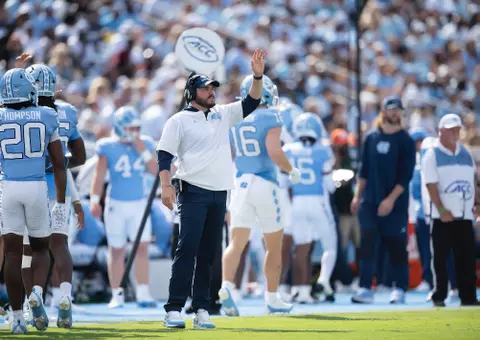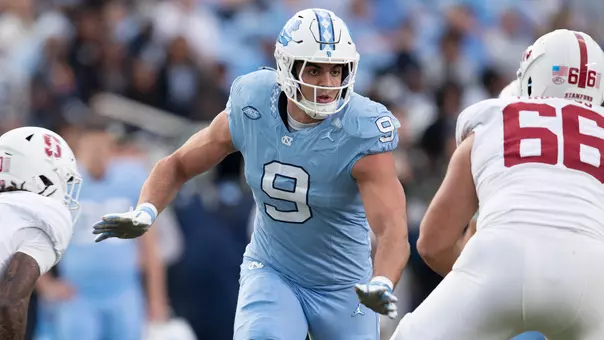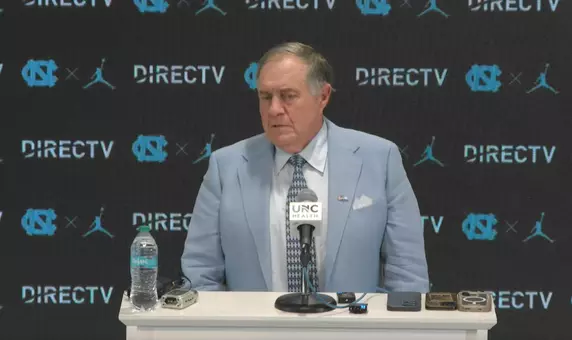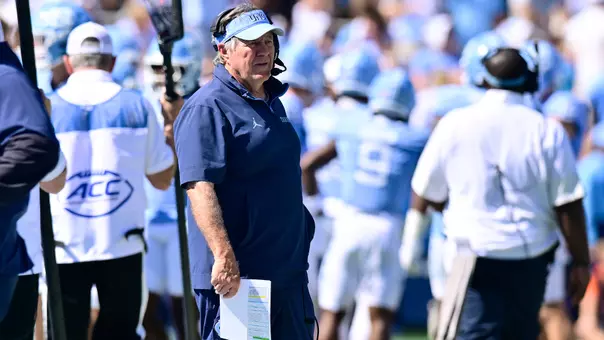University of North Carolina Athletics
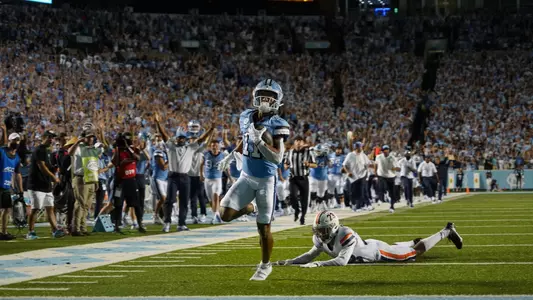
Extra Points: Heels Vs. Hoos
October 23, 2025 | Football, Featured Writers, Lee Pace, Extra Points
In the beginning, back in the early 1900s when Henry Ford was inventing the assembly line and Charles Lindbergh made the first trans-Atlantic airplane flight, the big rivalries for the University of North Carolina football team were not with Duke and N.C. State.
There was a 28-year lag beginning in 1894 when Carolina's football team and the school known originally as Trinity College did not play, and when the series resumed in 1922, Carolina bounced its Durham neighbors 105-to-zip over the first six years of the renewal.
The Tar Heels were dominant over N.C. State by a 204-to-0 margin over six games in the late-1800s and lost only three games to the team from West Raleigh by the end of the Roaring Twenties.
No, THE GAME in the early 1900s was Carolina vs. the University of Virginia.
"The Carolina-Virginia game is to the South what the Yale-Harvard game is to the North, and with this idea in view perhaps can be understood the intense and enthusiastic interest which this game always arouses," noted a 1906 passage in The Yackety Yack, the Carolina student yearbook.
The university in Chapel Hill had been in operation for one century when college football evolved in the 1880s, and Virginia was into its seventh decade of existence. They were the flagship institutions in neighboring states, 175 miles apart. Their alumni rolls were populated with doctors, lawyers and professionals. Both campuses were graced with elegant building designs, with the noted architecture firm of McKim Mead & White's fingerprints all over Polk Place in Chapel Hill and Thomas Jefferson having drawn the Rotunda and Lawn in Charlottesville. And both towns had bucolic central business districts—Franklin Street in Chapel Hill and The Corner in Charlottesville.
No wonder they wanted to clean each other's clocks every November.
"Knowing both institutions inside-out, I have always felt Virginia and Carolina are maybe the two schools most alike of any pair in the ACC," says John Swofford, who retired from his job as ACC Commissioner in 2021.
Consider the most recent rankings for athletic performance and academic prowess.
Carolina in the Learfield Directors Cup has finished eighth, seventh and fourth from 2023-25; Virginia has finished fourth, fifth and 12th those same years.
In the U.S. News & World Report Best College rankings for 2026, Carolina and Virginia are in lockstep at No. 4 among top public universities.
Swofford has behind-the-curtain perspectives on both universities, having played football at Carolina (Letterman 1969-71), worked in the Virginia Athletic Department (1973-76) and served as the Carolina Athletic Director (1980-97) before moving to the ACC.
"They both have great tradition in every respect—on and off the field and in the classroom. Both have great appreciation for academics. Both are public universities that lean toward the private institutions in some respects. Virginia and Carolina have nationally prominent, broad-based athletic programs.
"Those similarities athletically and academically drive the rivalry."
The first game between the Tar Heels and Cavaliers occurred on Oct. 22, 1892. It was played on the Virginia campus and won by the home team, 30-18. It was billed as the "championship of the South." The squads met again a month later in Atlanta as part of a "football carnival" held annually around Thanksgiving that brought in teams such as Georgia, Sewanee, Vanderbilt and Agricultural and Mechanical College of Alabama (later to become Auburn University). The Tar Heels evened the ledger with a 26-0 whitewashing of Virginia and finished their season at 5-1.
One newspaper noted the rousing welcome the Tar Heels received upon arrival at University Station from Atlanta.
"The train was decorated with the University colors, white and blue," the News & Observer reported. "On arrival at Chapel Hill, the returning heroes were given a rousing ovation and were escorted up into the village amidst great enthusiasm."
Officials at both Virginia and Carolina realized neither school had a venue large enough to accommodate potential interest and that a game destined to become a rivalry deserved a "save the best for last" spot on the schedule. And so beginning in 1893 and running through 1916 (before a two-year hiatus for World War I), the game was played on Thanksgiving weekend in Richmond. The site was Island Park, known today as Mayo Island, which was situated alongside the James River just south of downtown.
One passage in The Tar Heel newspaper leading up to the game lent interesting perspective on the evolution of school spirit.
"Let everyone that can go to Richmond on Thanksgiving Day, as a duty you owe your alma mater and let's give the boys a rousing send-off when they come onto the field," read one missive. "Of course we will win, victory or death!"
Trains brought fans to Richmond from every direction, and the atmosphere was described as "such excitement never before was seen in Richmond." Virginia prevailed in the Thanksgiving Day game, 16-0.
"It was the finest exhibition of the sport ever seen in this city, and 3,500 spectators witnessed the contest," said the Richmond Times-Dispatch.
This rivalry hitting game No. 130 at noon Saturday and known as "The South's Oldest Rivalry" has endured many twists and turns over the next century.
Virginia dominated early, winning 17 of the first 22 games. But Tar Heel fans were stoked enough despite the Cavaliers' superiority to clamor for tickets throughout the 1920s, and it was an overflow crowd estimated at 16,000 trying to get into Emerson Field on the Carolina campus with its 2,400-seating capacity that prompted UNC officials to build a bigger stadium. Kenan Stadium opened for the 1927 Virginia game, with the Tar Heels prevailing on Thanksgiving Day with a 14-13 win.
That was a good omen as Carolina went on a half century-plus of tyranny, posting a 43-13 record over the Cavaliers from 1927-82, many of those wins coming in the 1970s when Tar Heel Coach Bill Dooley was beating Virginia with native Virginians (a la Mike Voight, Amos Lawrence, Buddy Curry, Lawrence Taylor and Ricky Barden).
The Cavalier program pirouetted with the hiring in 1982 of the tough and taciturn George Welsh, who immediately choked off the Virginia-to-Chapel Hill recruiting pipeline. The Cavaliers in November 1983 beat a Tar Heel team that only a week before had been ranked No. 10 in the nation; their 17-14 win prompted Cavalier fans to storm the field at Scott Stadium, and that proved an omen as well.
Carolina would then lose 14 straight games in Charlottesville through 2008. It was called The Streak, The Curse, The Scourge, The Affliction, The Troubles—pick your name for that irksome period. Want to give a Tar Heel fan the cold shivers? Mention the name Charles Way (diving leap over the goal-line scrum for the winning score in 1993) or Antwan Harris (95-yard interception and touchdown that turned the tide in an apparent Tar Heel victory in 1996).
Carolina certainly had some bright moments at home during that period, with safety Omar Brown breaking up a last-gasp pass to secure a 22-17 win over ninth-ranked Virginia in 1995, and a Dre Bly pick-six ignited a furious second half rally in 1997 with Carolina rolling to a 48-20 triumph.
The Tar Heels finally ended their Scott Stadium misery on a damp, misty evening in 2010. T.J. Yates nailed Dwight Jones for an 81-yard score on the game's first play, the Tar Heels intercepted five passes, and they were never challenged in a 44-10 victory.
"There's a lot of people who've put on that blue helmet and that blue jersey who've come up here and gotten their hearts broken," Tar Heel Coach Butch Davis said. "A lot of people are happy tonight."
The last two games in the series have reflected the ebbs and flows of the rivalry.
Virginia stuck a dagger in the Tar Heels' playoff hopes in 2023 by coming into Kenan Stadium to face a 6-0 and No. 10-ranked Carolina team by controlling the clock and field position and escaping with a 31-27 win.
And last year in Charlottesville, the Tar Heels were emerging from the heartache and fog of teammate Tylee Craft's death and enjoyed their most fun day of the season—a 41-14 romp that included 10 quarterback sacks and an 84-yard pick-six by a defensive tackle, Jahvaree Ritzie.
"The two schools have played each other for so long, the rivalry will be there forever," Swofford says. "To the players during my day, it was a big rivalry game. It was a game you marked on the schedule back in the summer. Regardless of the records, the games always seemed close and competitive."
Chapel Hill writer Lee Pace (Carolina '79) has been writing about Tar Heel football under the "Extra Points" banner since 1990 and reporting from the sidelines on radio broadcasts since 2004. Write him at leepace7@gmail.com and follow him @LeePaceTweet.
There was a 28-year lag beginning in 1894 when Carolina's football team and the school known originally as Trinity College did not play, and when the series resumed in 1922, Carolina bounced its Durham neighbors 105-to-zip over the first six years of the renewal.
The Tar Heels were dominant over N.C. State by a 204-to-0 margin over six games in the late-1800s and lost only three games to the team from West Raleigh by the end of the Roaring Twenties.
No, THE GAME in the early 1900s was Carolina vs. the University of Virginia.
"The Carolina-Virginia game is to the South what the Yale-Harvard game is to the North, and with this idea in view perhaps can be understood the intense and enthusiastic interest which this game always arouses," noted a 1906 passage in The Yackety Yack, the Carolina student yearbook.
The university in Chapel Hill had been in operation for one century when college football evolved in the 1880s, and Virginia was into its seventh decade of existence. They were the flagship institutions in neighboring states, 175 miles apart. Their alumni rolls were populated with doctors, lawyers and professionals. Both campuses were graced with elegant building designs, with the noted architecture firm of McKim Mead & White's fingerprints all over Polk Place in Chapel Hill and Thomas Jefferson having drawn the Rotunda and Lawn in Charlottesville. And both towns had bucolic central business districts—Franklin Street in Chapel Hill and The Corner in Charlottesville.
No wonder they wanted to clean each other's clocks every November.
"Knowing both institutions inside-out, I have always felt Virginia and Carolina are maybe the two schools most alike of any pair in the ACC," says John Swofford, who retired from his job as ACC Commissioner in 2021.
Consider the most recent rankings for athletic performance and academic prowess.
Carolina in the Learfield Directors Cup has finished eighth, seventh and fourth from 2023-25; Virginia has finished fourth, fifth and 12th those same years.
In the U.S. News & World Report Best College rankings for 2026, Carolina and Virginia are in lockstep at No. 4 among top public universities.
Swofford has behind-the-curtain perspectives on both universities, having played football at Carolina (Letterman 1969-71), worked in the Virginia Athletic Department (1973-76) and served as the Carolina Athletic Director (1980-97) before moving to the ACC.
"They both have great tradition in every respect—on and off the field and in the classroom. Both have great appreciation for academics. Both are public universities that lean toward the private institutions in some respects. Virginia and Carolina have nationally prominent, broad-based athletic programs.
"Those similarities athletically and academically drive the rivalry."
The first game between the Tar Heels and Cavaliers occurred on Oct. 22, 1892. It was played on the Virginia campus and won by the home team, 30-18. It was billed as the "championship of the South." The squads met again a month later in Atlanta as part of a "football carnival" held annually around Thanksgiving that brought in teams such as Georgia, Sewanee, Vanderbilt and Agricultural and Mechanical College of Alabama (later to become Auburn University). The Tar Heels evened the ledger with a 26-0 whitewashing of Virginia and finished their season at 5-1.
One newspaper noted the rousing welcome the Tar Heels received upon arrival at University Station from Atlanta.
"The train was decorated with the University colors, white and blue," the News & Observer reported. "On arrival at Chapel Hill, the returning heroes were given a rousing ovation and were escorted up into the village amidst great enthusiasm."
Officials at both Virginia and Carolina realized neither school had a venue large enough to accommodate potential interest and that a game destined to become a rivalry deserved a "save the best for last" spot on the schedule. And so beginning in 1893 and running through 1916 (before a two-year hiatus for World War I), the game was played on Thanksgiving weekend in Richmond. The site was Island Park, known today as Mayo Island, which was situated alongside the James River just south of downtown.
One passage in The Tar Heel newspaper leading up to the game lent interesting perspective on the evolution of school spirit.
"Let everyone that can go to Richmond on Thanksgiving Day, as a duty you owe your alma mater and let's give the boys a rousing send-off when they come onto the field," read one missive. "Of course we will win, victory or death!"
Trains brought fans to Richmond from every direction, and the atmosphere was described as "such excitement never before was seen in Richmond." Virginia prevailed in the Thanksgiving Day game, 16-0.
"It was the finest exhibition of the sport ever seen in this city, and 3,500 spectators witnessed the contest," said the Richmond Times-Dispatch.
This rivalry hitting game No. 130 at noon Saturday and known as "The South's Oldest Rivalry" has endured many twists and turns over the next century.
Virginia dominated early, winning 17 of the first 22 games. But Tar Heel fans were stoked enough despite the Cavaliers' superiority to clamor for tickets throughout the 1920s, and it was an overflow crowd estimated at 16,000 trying to get into Emerson Field on the Carolina campus with its 2,400-seating capacity that prompted UNC officials to build a bigger stadium. Kenan Stadium opened for the 1927 Virginia game, with the Tar Heels prevailing on Thanksgiving Day with a 14-13 win.
That was a good omen as Carolina went on a half century-plus of tyranny, posting a 43-13 record over the Cavaliers from 1927-82, many of those wins coming in the 1970s when Tar Heel Coach Bill Dooley was beating Virginia with native Virginians (a la Mike Voight, Amos Lawrence, Buddy Curry, Lawrence Taylor and Ricky Barden).
The Cavalier program pirouetted with the hiring in 1982 of the tough and taciturn George Welsh, who immediately choked off the Virginia-to-Chapel Hill recruiting pipeline. The Cavaliers in November 1983 beat a Tar Heel team that only a week before had been ranked No. 10 in the nation; their 17-14 win prompted Cavalier fans to storm the field at Scott Stadium, and that proved an omen as well.
Carolina would then lose 14 straight games in Charlottesville through 2008. It was called The Streak, The Curse, The Scourge, The Affliction, The Troubles—pick your name for that irksome period. Want to give a Tar Heel fan the cold shivers? Mention the name Charles Way (diving leap over the goal-line scrum for the winning score in 1993) or Antwan Harris (95-yard interception and touchdown that turned the tide in an apparent Tar Heel victory in 1996).
Carolina certainly had some bright moments at home during that period, with safety Omar Brown breaking up a last-gasp pass to secure a 22-17 win over ninth-ranked Virginia in 1995, and a Dre Bly pick-six ignited a furious second half rally in 1997 with Carolina rolling to a 48-20 triumph.
The Tar Heels finally ended their Scott Stadium misery on a damp, misty evening in 2010. T.J. Yates nailed Dwight Jones for an 81-yard score on the game's first play, the Tar Heels intercepted five passes, and they were never challenged in a 44-10 victory.
"There's a lot of people who've put on that blue helmet and that blue jersey who've come up here and gotten their hearts broken," Tar Heel Coach Butch Davis said. "A lot of people are happy tonight."
The last two games in the series have reflected the ebbs and flows of the rivalry.
Virginia stuck a dagger in the Tar Heels' playoff hopes in 2023 by coming into Kenan Stadium to face a 6-0 and No. 10-ranked Carolina team by controlling the clock and field position and escaping with a 31-27 win.
And last year in Charlottesville, the Tar Heels were emerging from the heartache and fog of teammate Tylee Craft's death and enjoyed their most fun day of the season—a 41-14 romp that included 10 quarterback sacks and an 84-yard pick-six by a defensive tackle, Jahvaree Ritzie.
"The two schools have played each other for so long, the rivalry will be there forever," Swofford says. "To the players during my day, it was a big rivalry game. It was a game you marked on the schedule back in the summer. Regardless of the records, the games always seemed close and competitive."
Chapel Hill writer Lee Pace (Carolina '79) has been writing about Tar Heel football under the "Extra Points" banner since 1990 and reporting from the sidelines on radio broadcasts since 2004. Write him at leepace7@gmail.com and follow him @LeePaceTweet.
Players Mentioned
UNC Wrestling: #22 Carolina Downs #17 West Virginia in Carmichael, 27-7
Saturday, December 13
Hubert Davis Post-Georgetown Press Conference
Monday, December 08
Carolina Insider: Rapid Reactions – Men’s Basketball vs. Georgetown – December 7, 2025
Monday, December 08
UNC Men's Basketball: Wilson & Veesaar Lead 81-61 Win Over Hoyas
Monday, December 08











